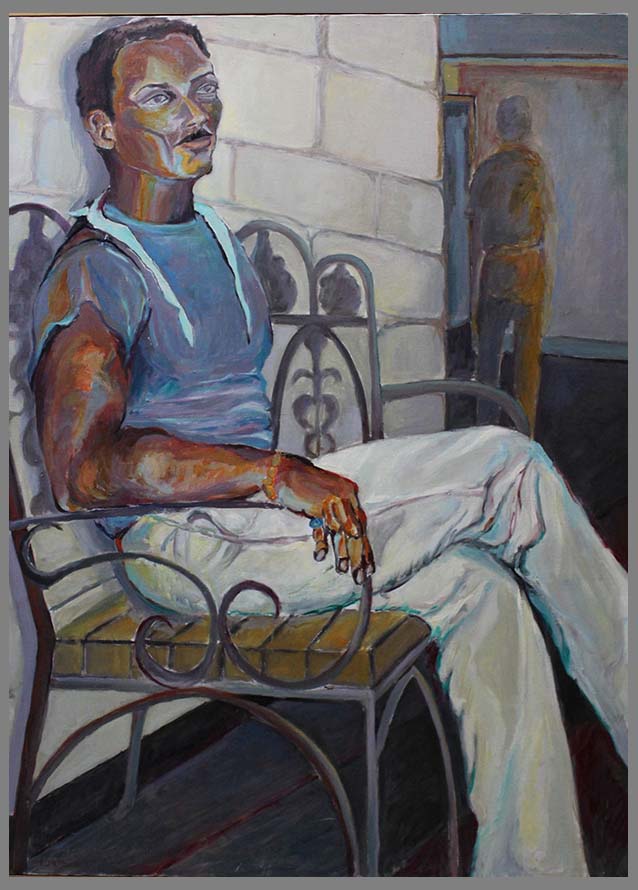

FRANCES JACOBSON
"JIMMY GOT THE JOB'
OIL ON CANVAS, SIGNED
AMERICAN, C.1990
48 X 36 INCHES
Frances Jacobson
1923-2011
Born in Brooklyn, New York on October 31, 1923 (Hallowe'en), Frances Jacobson was the wife of a dentist in Queens, New York. She was also a talented Feminist and Humanist artist. Raised by Jewish-Russian immigrants, Frances always knew she was meant to be an artist. But she did not get the opportunity to achieve that dream until her 60's, after raising three children and caring for a daughter with a serious health issue for many years.
During her lifetime she received many favorable reviews from art critics. She enjoyed art exhibitions and a few prizes, but never became famous. Frances Jacobson was often compared to the character portrait painter Alice Neel. Her most influential teacher was the well known figural painter Raphael Soyer, whose style is reflected in her portraits, especially her nudes.
In 1942, Frances was offered a full art scholarship to Cornell University in New York, but her old-fashioned father refused to pay for her room and board. Instead, he encouraged her to get married, which she did. Later in life, at age 65, Jacobson graduated from Adelphi University and began painting portraits. No one knows what she might have achieved had she become a professional artist in the 1940's and 50's.
In the 1980's, during the decade of Alice Neel's final years, Jacobson painted character portraits of hundreds of people she knew as well as some people she had only met briefly. Frances Jacobson became a "Collector Of Souls", the term used to describe Neel, America's foremost feminist portrait painter of the 1960's to the 1980's. Very few female artists of the 1980's deserve to be compared to Alice Neel. Frances Jacobson is one of them.
Unlike Alice Neel, who painted celebrities like Andy Warhol (as well as rich folks and street people), Frances Jacobson mostly painted friends, family and neighbors. Her two sons, David and Mark (both artists) said that their mother "rarely painted happy people." As you can see from the troubled faces of her subjects, who sometimes displayed the hint of a smile, Frances made no attempt to alter what people looked like, or what they were feeling, or to depict them in a more positive light. Rather, like Alice Neel, she was more concerned with painting "who they were on the inside" and showing this through what they looked like on the outside.
Jacobson strove for happiness, but judging from what we know about her, she did not experience much joy in life. Like her subjects, she often looked better on the outside than how she felt on the inside.
Her life was harsh, disturbing, challenging and decidedly dark. This comes across through the powerful and emotional images she created of the people she surrounded herself with. Many of Jacobson's characters were members of what she called "The Book Club", a group of people with whom she had something in common: All were members of Alcoholics Anonymous.
At the age of 5, the artist contracted polio, which haunted her all of her life. She was unable to use one of her hands properly, and her son David explains that many of the hands in her portraits, often oversize and grotesque, reflect the problem she had with her own hands. In fact, David thinks some of the hands of her subjects are actually her own hands. The artist created a number of extremely revealing self portraits.
In 1983, Jacobson won a prize at the Salmagundi Club for Subway Madonna. In 1987, she traveled to Ghana in Africa where she photographed and painted the villagers and tribal chiefs, many of whom had never seen a white person before. These paintings are considered her finest academic work and several were sold at a New York City art show in 1988. Her large paintings can best be described as "moving and very personal."
Over the years a small number of Jacobson's paintings have been sold at various east coast galleries, and some were given to friends at her funeral. But the family has preserved virtually everything the artist created during her brief peak years in the 1980's and early 90's.